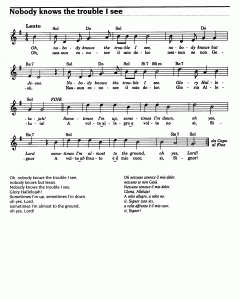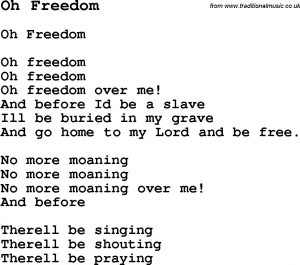The term “sorrow songs” was coined by W.E.B. DuBois and represented songs that expressed the suffering and unjust treatment of enslaved African Americans throughout the period of slavery in the US. Sorrow songs conveyed sadness and the lyrics and melodies were often very direct about the experiences that African Americans had while enslaved. DuBois commented that although the songs were unknown to him, he knew the songs as a part of himself. 
Many of the Sorrow Songs and Negro folk songs had lots of spiritual references because the only book that was read to slaves was the bible. Although Sorrow Songs implies hardships and literal sadness, there were still many songs that represented hopes and aspirations for a better future. The lyrics of these more hopeful songs would start with the hardships of slavery and gravitate towards a lighter topic of being enlightened by Christianity and the hope and faith that God will look over the slaves.
Due to the deep and meaningful lyrics in Sorrow Songs, many leaders and teachers recognized the significance of these songs for African American culture. They would often teach the importance of the melodies and lyrics of the songs and stress the respect that younger African Americans should have for their music. In a news article from the Chicago Defender in 1922, “A History of Music That Moved World: Story of Songs of Hope That Came From the Hearts of Slaves”, the author argues that these songs were so important for African Americans was because they were created by African Americans to express the African American experience through slavery. Moreover, the author states that certain other Negro folk songs don’t hold as much weight because although they reflected the African American experience, they were written by white men.
Although the term Sorrow Songs has become less prevalent and spirituals are more commonly known, the experiences represented through Sorrow Songs have not been lost to time. Spirituals have since evolved from the slave songs and Sorrow songs to become more polished forms of music that still maintain their characteristic moods that were created under intense hardships and deep sorrows.
References:
“A History of Music that Moved World: Story of Songs of Hope that Came from the Hearts of Slaves.” The Chicago Defender (National edition) (1921-1967), Dec 30, 1922, pp. 13. ProQuest, https://www.proquest.com/historical-newspapers/history-music-that-moved-world/docview/491968896/se-2.
Nobody knows the trouble I see sheet music. Easy Sheet Music. (2021, April 11). Retrieved October 10, 2022, from http://easysheetmusic.altervista.org/nobody-knows-the-trouble-i-see-sheet-music-guitar-chords-lyrics/
Peyton, Dave. “THE MUSICAL BUNCH: THINGS IN GENERAL SLAVE SONGS.” The Chicago Defender (National edition) (1921-1967), Nov 17, 1928, pp. 6. ProQuest, https://www.proquest.com/historical-newspapers/musical-bunch/docview/492211749/se-2.
Spiritual lyrics: Oh freedom. Negro Spiritual/Slave Song Lyrics for Oh Freedom. (n.d.). Retrieved October 10, 2022, from http://www.traditionalmusic.co.uk/negro-spirituals/oh_freedom.htm
W.E.B. Du Bois. “”The Sorrow Songs,” from The Souls of Black Folk”. Book excerpt, 1903. From Teaching American History. https://teachingamericanhistory.org/document/the-sorrow-songs/

